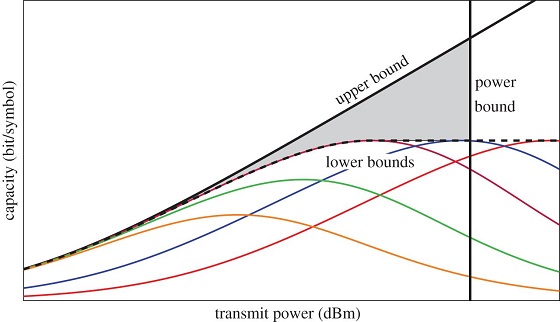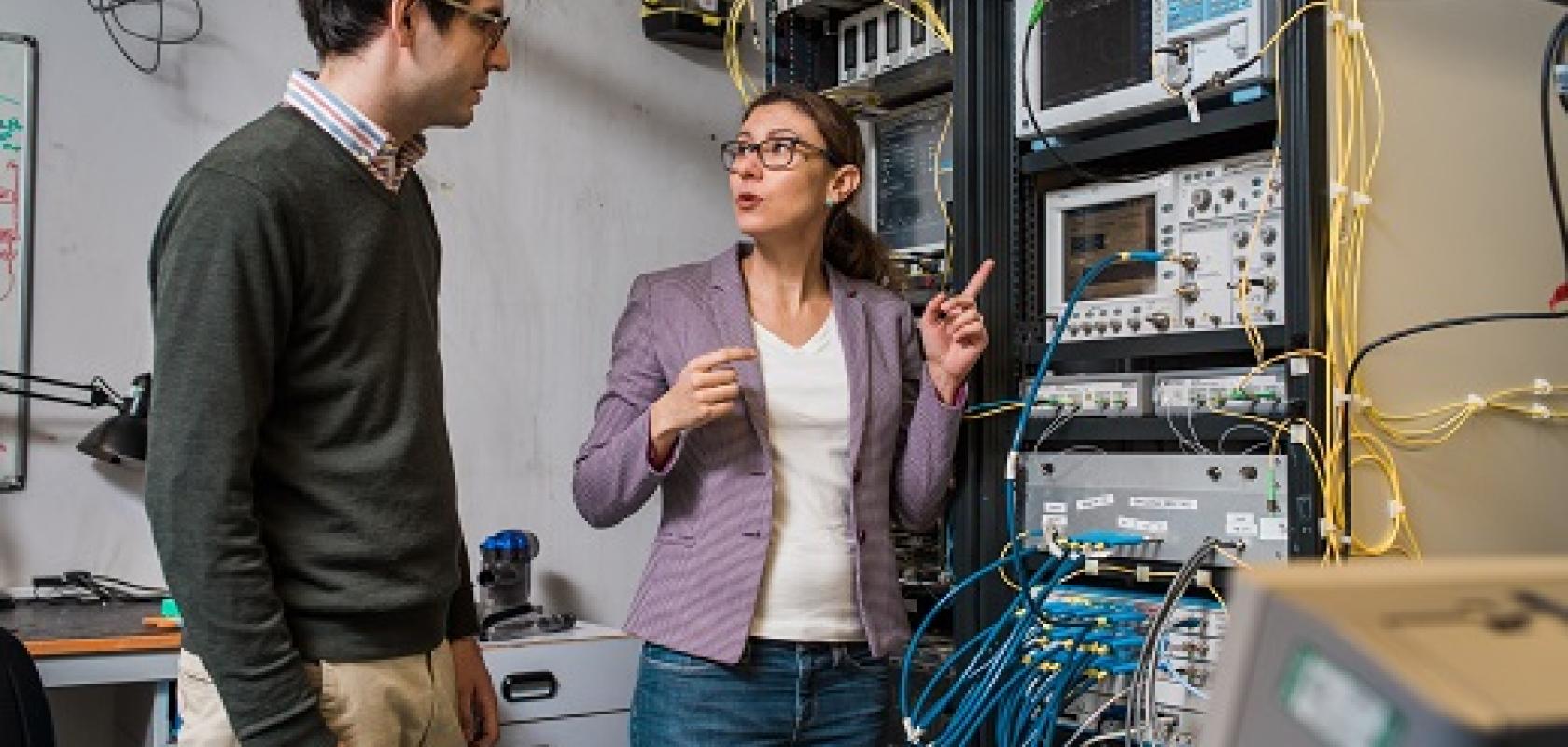Between the covers of optical communication research journals, heated arguments have been waged, leading to ‘a stand-up row, almost’, according to Professor Polina Bayvel from University College London. The disagreements centre on whether optical fibres exhibit a ‘nonlinear Shannon limit’ to their capacity. The dispute emerges from a question that challenges the whole industry. Is the future of fibre-optic technology already facing a fundamental, impenetrable, nonlinearity obstacle? It’s a theoretical question with potentially huge practical implications.
‘As you send more data and use higher-order modulation formats, you need more power,’ Bayvel explains. Increasing the power per unit area, which is also known as intensity, can change the glass fibre’s refractive index through the Kerr effect. Refractive index changes in proportion to the square of the intensity, although this rapid, nonlinear change only becomes significant at high intensity. Exploring the consequences of this, numerous studies have suggested that, beyond some optimal power level, the performance of optical fibre, and thus its capacity, will inevitably decline.
‘A number of researchers started calling it nonlinear Shannon capacity,’ Bayvel said. ‘That’s a misnomer.’ The term alludes to the Shannon limit, the theoretical maximum information transfer rate of a communications channel given a particular noise level. Bayvel and others argue that currently observed nonlinear limits are not the fundamental limit for fibre channel capacity, which is the maximum rate of reliable communication. Appropriate coding or modulation formats could reach a fibre’s true capacity, she says.
Whether these limits are fundamental or not is a question that has grown in importance, as networks approach them. ‘Since the development of optical erbium-doped fibre amplifiers [EDFAs] 30 years ago, the performance of optical systems has been a trade-off between the noise coming from the amplifiers, and nonlinear distortions,’ explained Gabriel Charlet, research group director at Nokia Bell Labs in Nozay, France. ‘By increasing optical power into the fibre, the impact of noise from optical amplifiers reduces while nonlinear distortions increase. Minimising nonlinear distortion has been a long quest to allow injection of higher powers into the fibre, providing a better optical signal-to-noise ratio. For more than 10 years, with the development of coherent detection associated with digital signal processing [DSP], more and more teams have looked at ways to mitigate nonlinear distortions through DSP.’

The Unloc project is jointly led by Bayvel – a collaboration between UCL, Aston University and the University of Cambridge
The models of optical fibre channels needed to do this have serious shortcomings – which, Bayvel suggests, led to the wrangling over nonlinear Shannon limit to capacity. ‘Each pulse in a sequence will change the refractive index for the subsequent pulses,’ she said. Testing any model requires long – in some cases preferably infinite – pulse series. ‘Even if you’re considering only 20 symbols, you need 220, or over a million, sequences to test in the channel model, which is really hard,’ she adds.
Optical fibre channel models therefore confounded the Shannon limit formula, which assumes the signal can be separated from the noise. Models typically represent nonlinearity as Gaussian noise, which is dependent on signal power, rather than being independent from the signal. ‘If you go along that line you can never mitigate nonlinearity,’ Bayvel said. ‘We know we can mitigate nonlinearity, so there was something wrong with the definition.’
Limit unknown
Marco Secondini, a researcher at Scuola Superiore Sant’Anna in Pisa, asserts in a paper published in the February 15, 2016 issue of Journal of Lightwave Technology, that proof of a nonlinear Shannon limit has not been demonstrated. He stresses the Gaussian model of nonlinear interference is a rough approximation made to simplify analysis. ‘It gives accurate results to estimate the performance of conventional systems, but if you use it for capacity analysis, you simply end up with an achievable information rate, not with an ultimate capacity limit,’ Secondini added. ‘We don’t know the ultimate capacity limit of optical fibres.’ And while Secondini asserts that most scientists now agree that there is no proof of a nonlinear Shannon limit, many doubt that knowing this will bring practical benefits.
But Secondini, Bayvel, and others are more optimistic that the situation will create opportunities. ‘If there is no nonlinear Shannon limit – or if it is much higher than currently predicted – the information rate through existing optical fibres could be still significantly increased before other fundamental limits like fibre melting are reached,’ Secondini said. ‘Finding out the ultimate capacity limit will give important indications for the development of future optical networks. For instance, it will help us to understand whether to invest in new kind of fibres and network architectures, or more sophisticated DSP techniques and technologies.’
Since 2012 the UK-based Unloc project jointly led by Bayvel – a collaboration between UCL, Aston University and the University of Cambridge aimed at unlocking the capacity of optical communications – has been developing just this kind of understanding. It has devised better optical fibre channel models and modulation formats, enabling Unloc to go beyond mitigating nonlinearities, towards understanding the interplay between nonlinearities and noise. ‘The noise from optical amplifiers has nonlinear interactions and those are unpredictable,’ Bayvel explained. ‘We’ve shown that you can really mitigate nonlinearity almost completely, bar this little bit of nonlinear noise interaction that you can’t do anything about.’

Generic upper and lower bounds on the capacity of fibre-optic channels. An upper bound on the average transmit power is also shown, which confines the capacity to a triangular region (shaded). It is not known where in this region the true capacity lies. From Review article: Implications of information theory in optical fibre communications, Agrell, et al. Phil. Trans. R. Soc. A 2016 374 20140438; DOI: 10.1098/rsta.2014.0438. Published 25 January 2016.
Unloc’s model enables researchers to build on an existing DSP approach to nonlinearity mitigation widely used by equipment manufacturers, known as digital back propagation (DBP). DBP involves solving an inverse nonlinear Schrödinger equation to undo acquired nonlinear distortion. ‘The coherent receiver detects both the amplitude and the phase of the signal,’ Bayvel explained.
The DSP chips in the receiver invert the phase and amplitude detected, and digitally propagate the virtual signal on the reverse journey. This allows the receiver to undo nonlinearities, enabling higher power and longer reach DWDM transmission over standard optical fibre without dispersion compensation.
However, DBP’s benefit is limited by the amount of back-propagated noise from transceivers, and particularly by nonlinear signal-noise interactions, which increase with the bandwidth propagated. Unloc has therefore been exploring shifting the reverse journey from the digital to the physical domain, by using optical components. ‘That’s not yet practically ready to be used, but very exciting,’ Bayvel says, especially the work done by Andrew Ellis’s Aston group.
Channelling efforts
The Unloc team has also used models that accurately capture nonlinear effects to take channel properties into account to approach simulating entire networks. For example, DBP is most effective to mitigate nonlinearities when applied to multiple wavelength channels. But in a paper in the March 15 issue of Journal of Lightwave Technology a group led by Cambridge’s Seb Savory showed that applying DBP to only single-wavelength channels can be more effective across an entire network. Such findings highlight the challenge in improving nonlinear mitigation, and the level of technology needed to deploy it. ‘There’s high complexity in implementing the DSP and doing the analysis, so we have machine learning techniques coming to help us,’ Bayvel said. ‘These changes will be enabled by completely new types of intelligent transceivers equipped with performance monitoring and clever DSP.’
Currently, nonlinear mitigation/compensation techniques enable networks to operate slightly in the nonlinear regime of the fibre, explains Alex Alvarado from the Eindhoven University of Technology (TU/e). In this pseudo-nonlinear regime, nonlinearity manifests as signal distortion, explains Alvarado, who also worked as an Unloc researcher on the DBP analysis and advanced modulation formats. Beyond that region, in the highly nonlinear regime, ‘the system completely breaks down’, he says. DBP is a good example of a technology targeting the pseudo-nonlinear regime, he adds. ‘However, you’re still using a linear transmitter and compensating for nonlinearities,’ Alvarado said. ‘You’re not thinking about what is going to happen in the channel before you design your transmitter.’
Alvarado is now working on redesigning communication systems to tailor them to the nonlinear fibre optical channel. ‘We want to design something that works in the highly nonlinear regime but very likely will not work in the linear regime,’ he said. Alvarado believes going deep into the highly nonlinear regime could double existing transmission rates.
The TU/e team’s approach focuses on interconverting the discrete zeroes and ones of digital data into continuous optical waves. ‘It’s typically done using techniques borrowed from communication systems where you don’t have nonlinearities,’ Alvarado said. Until now, the industry’s approach has evolved from thinking about the discrete digital domain, he believes, before moving to the continuous optical one. By contrast, Alvarado recently won a €1.5 million European Research Council starting grant to work in the opposite direction. His team began work at the start of the year, looking at optical fibre and its nonlinearities. Evidence that this approach can work comes from the nonlinear Fourier transform, which Alvarado calls a ‘very good example of a technique that embraces nonlinearity and is tailored to the nonlinear optical channel,’ he said.
Unloc’s co-director, Aston’s Professor Sergei Turitsyn, has been pioneering the nonlinear Fourier transform using an ‘inverse scattering method’, according to Bayvel. ‘These are nonlinear techniques that came from statistical physics,’ she explained. ‘You code the pulses so that they can go through a network or a single point-to-point system, and they’re not affected by nonlinearity. It’s at a very early stage – but it’s exciting.’
Similarly, systems have been designed to exploit solitons – self-reinforcing solitary waves that maintain their shape as they travel over long distances – by considering what happens in the fibre channel, Alvarado says. Nonlinear and dispersive effects in the fibre cancel out, enabling pulses to travel without distortion.
A very different network
Efforts to resolve nonlinear effects using soliton techniques in the 1990s and 2000s were a first tentative attempt to mitigate nonlinearity, Nokia’s Charlet notes. They were not successful, in part due to limitations in the technology available at the time. Solitons are a particular solution of the nonlinear Fourier transform, says Charlet.
Other proposed approaches to compensating for nonlinearities include optical methods such as optical phase conjugation (OPC). Charlet points out that, because OPC would require insertion of new devices along the optical line, it would be difficult for carriers to accept ‘unless very significant gains are demonstrated.’ Methods based on DSP need only changes in the transceiver at each end of an optical line, Charlet observes. But he’s concerned that complexity of the DSP involved can be too large to be practically managed in real systems.
Alvarado echoes these concerns. ‘One of the goals of digital nonlinear compensation is to inject more power into the fibre,’ he said. ‘However, this power is much smaller than the power required by the DSP, especially if powerful techniques are used. Therefore, I believe it is very important to develop low power consumption algorithms that can deal with nonlinearities in an efficient way.’

Unloc has been exploring shifting the reverse journey from the digital to the physical domain, by using optical components
And while the nonlinear Fourier transform gives Alvarado ‘hope that there is more out there that we can use,’ he warns ‘we’re not sure it’s the right way of looking at the problem,’ cautioning ‘the nonlinear Fourier transform works well on paper, but people have seen that things in the actual channel don’t match exactly what the maths tells you.’
Finding alternative approaches is a ‘high-risk, high-reward’ undertaking, Alvarado admits, that will initially cover similar ground to Unloc. After developing new models and establishing channel capacity, he aims to use that information to design new equipment to approach that capacity. Even though these efforts will consider what’s happening in the fibre channel first, they’ll be implemented in software, rather than new uses of optical physics. ‘In information theory we think about a physical channel that you’re not allowed to change,’ Alvarado explained.
Yet optical methods like OPC are showing strength. A team including Unloc researchers has sent, using polarisation-multiplexed 256-QAM signals on 14 channels over 440km from London to Southampton and back. That equates to the largest data throughput yet transmitted using OPC. Bayvel and her colleagues initially sent the channels along a singlemode fibre, split into two simultaneously transmitted frequency sub-bands, with wavelengths 12nm apart. In Southampton, their optical phase conjugator separated the bands, conjugated the signals in a highly nonlinear optical fibre – exploiting its nonlinearity – and finally recombined them so that their frequencies are swapped.
Then, they send copies of the signal to both London ends of the fibre, the frequency inversion meaning distortions accumulating in the first half of the light’s journey are undone during the second. The process mitigates non-linearity, increasing the launch power window for each channel by 1dB compared to electronic dispersion compensation.
Whether or not approaches that mitigate and exploit nonlinearity add extra optical equipment, such sophisticated approaches will transform optical communications, Bayvel stresses. ‘The network has to be self-driving,’ she said. ‘It has to self-monitor and self-adjust. The key will be intelligent transceivers. This is where we think maybe machine learning will play a big part. The network will look very different, but will provide a much-improved digital infrastructure, better suited to the services of tomorrow.’


